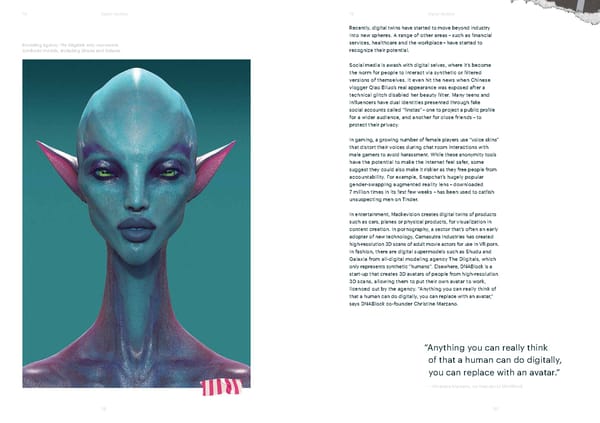T6 Digital doubles T6 Digital doubles Recently, digital twins have started to move beyond industry into new spheres. A range of other areas – such as financial Modeling agency The Diigitals only represents services, healthcare and the workplace – have started to synthetic models, including Shudu and Galaxia. recognize their potential. Social media is awash with digital selves, where it’s become the norm for people to interact via synthetic or filtered versions of themselves. It even hit the news when Chinese vlogger Qiao Biluo’s real appearance was exposed after a technical glitch disabled her beauty filter. Many teens and influencers have dual identities presented through fake social accounts called “finstas” – one to project a public profile for a wider audience, and another for close friends – to protect their privacy. In gaming, a growing number of female players use “voice skins” that distort their voices during chat room interactions with male gamers to avoid harassment. While these anonymity tools have the potential to make the internet feel safer, some suggest they could also make it riskier as they free people from accountability. For example, Snapchat’s hugely popular gender-swapping augmented reality lens – downloaded 7 million times in its first few weeks – has been used to catfish unsuspecting men on Tinder. In entertainment, Mackevision creates digital twins of products such as cars, planes or physical products, for visualization in content creation. In pornography, a sector that’s often an early adopter of new technology, Camasutra Industries has created high-resolution 3D scans of adult movie actors for use in VR porn. In fashion, there are digital supermodels such as Shudu and Galaxia from all-digital modeling agency The Diigitals, which only represents synthetic “humans”. Elsewhere, DNABlock is a start-up that creates 3D avatars of people from high-resolution 3D scans, allowing them to put their own avatar to work, licenced out by the agency. “Anything you can really think of that a human can do digitally, you can replace with an avatar,” says DNABlock co-founder Christine Marzano. “Anything you can really think of that a human can do digitally, you can replace with an avatar.” — Christine Marzano, co-founder of DNABlock 79 80
 Accenture-Fjord-Trends-2020-Report Page 37 Page 39
Accenture-Fjord-Trends-2020-Report Page 37 Page 39